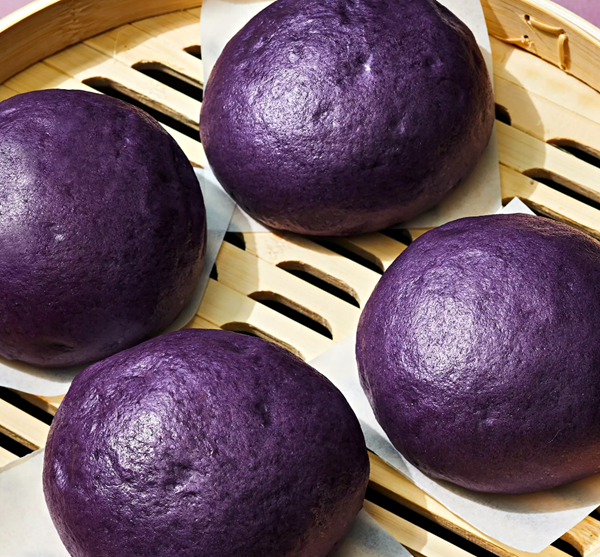Everything’s coming up ube
July 2, 2022 by DarcieI don’t know about you, but I’ve been seeing a lot of purple foods in my social media feeds recently. Everything from hamburger buns to drinks seem to be colored in an eye-catching deep lilac hue, and the ingredient that makes these colorful foods happen is one that hails from the Philippines: ube. If you’re interested in learning more about this striking root vegetable, Food & Wine provides a succinct yet thorough introduction.

Ube is a purple yam native to Southeast Asia “whose glimmering purple center, mild, sweet flavor, and coconut-like aroma” have cemented its status as king of Filipino sweets such as halo-halo. While it resembles a purple sweet potato, they are different: ube is moister and sweeter than its doppelganger, and has a nuttier flavor with hints of vanilla.
In the US, it is difficult to find fresh ube, but in more populous areas you might find it in the frozen section of Asian markets or see ube powder or extract in large supermarkets. The main attraction of the powder and extract form seems to be adding a vibrant purple hue to foods and drinks.
Ube hasn’t found its way into many Western cookbooks yet, but I’m sure that’s about to change. Currently, there are only 58 recipes in the EYB Library that call for ube in one of its various forms, with 16 of those recipes available online. It looks like most of those recipes are only weeks to months old, so it will be interesting to see how many ube recipes are there a year from now. That will determine if ube is just a flash in the pan for Western cooks or if it will make a lasting impact as it has in its native lands.
Categories
- All Posts (7075)
- Antipasto (2205)
- Author Articles (250)
- Book News (944)
- Cookbook Giveaways (996)
- Cookbook Lovers (262)
- Cooking Tips (116)
- Culinary News (299)
- Food Biz People (558)
- Food Online (800)
- Holidays & Celebrations (277)
- New Cookbooks (154)
- Recipes (1520)
- Shelf Life With Susie (231)
- What's New on EYB (134)
Archives
Latest Comments
- Indio32 on Four outstanding independently published cookbooks worth your attention
- nvernon on Four outstanding independently published cookbooks worth your attention
- fayegibson on Four outstanding independently published cookbooks worth your attention
- Pizzacat13 on Balli Balli – Cookbook Giveaway and Quick Bites
- Laura1 on For the Love of Lemons by Letitia Clark – Giveaway
- fms95032 on For the Love of Lemons by Letitia Clark – Giveaway
- fms95032 on 20 Amici – 40 Ricette Cookbook Giveaway
- fms95032 on French at Heart – Cookbook Giveaway
- Shelmar on Tea innovations
- dzm on 20 Amici – 40 Ricette Cookbook Giveaway